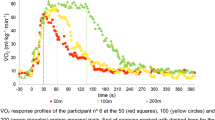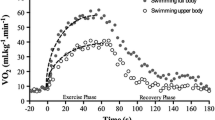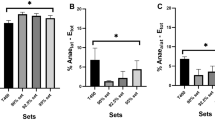Abstract
This study aimed to characterise both the \( \dot{V}{\text{O}}_{2} \) kinetics within constant heavy-intensity swimming exercise, and to assess the relationships between \( \dot{V}{\text{O}}_{2} \) kinetics and other parameters of aerobic fitness, in well-trained swimmers. On separate days, 21 male swimmers completed: (1) an incremental swimming test to determine their maximal oxygen uptake \( (\dot{V}{\text{O}}_{2\max } ) \), first ventilatory threshold (VT), and the velocity associated with \( \dot{V}{\text{O}}_{2\max } \) \( (v\dot{V}{\text{O}}_{2\max } ) \) and (2) two square-wave transitions from rest to heavy-intensity exercise, to determine their \( \dot{V}{\text{O}}_{2} \) kinetics. All the tests involved breath-by-breath analysis of freestyle swimming using a swimming snorkel. \( \dot{V}{\text{O}}_{2} \) kinetics was modelled with two exponential functions. The mean values for the incremental test were 56.0 ± 6.0 ml min−1 kg−1, 1.45 ± 0.08 m s−1; and 42.1 ± 5.7 ml min−1 kg−1 for \( \dot{V}{\text{O}}_{2\max } \), \( v\dot{V}{\text{O}}_{2\max } \) and VT, respectively. For the square-wave transition, the time constant of the primary phase (τp) averaged 17.3 ± 5.4 s and the relevant slow component (A′sc) averaged 4.8 ± 2.9 ml min−1 kg−1 [representing 8.9% of the end-exercise \( \dot{V}{\text{O}}_{2} \) (%A′sc)]. τp was correlated with \( v\dot{V}{\text{O}}_{2\max } \) (r = −0.55, P = 0.01), but not with either \( \dot{V}{\text{O}}_{{ 2 {\text{max}}}} \) (r = 0.05, ns) or VT (r = 0.14, ns). The %A′sc did not correlate with either \( \dot{V}{\text{O}}_{{ 2 {\text{max}}}} \) (r = −0.14, ns) or \( v\dot{V}{\text{O}}_{2\max } \) (r = 0.06, ns), but was inversely related with VT (r = −0.61, P < 0.01). This study was the first to describe the \( \dot{V}{\text{O}}_{2}\) kinetics in heavy-intensity swimming using specific swimming exercise and appropriate methods. As has been demonstrated in cycling, faster \( \dot{V}{\text{O}}_{2} \) kinetics allow higher aerobic power outputs to be attained. The slow component seems to be reduced in swimmers with higher ventilatory thresholds.





Similar content being viewed by others
References
Andersen P, Henriksson J (1977) Training induced changes in the subgroups of human type II skeletal muscle fibres. Acta Physiol Scan 99(1):123–125
Bailey SJ, Wilkerson DP, Dimenna FJ, Jones AM (2009) Influence of sprint training on pulmonary O2 uptake and muscle deoxygenation kinetics in humans. J Appl Physiol 106(6):1875–1887
Barbosa T, Silva AJ, Reis AM, Costa M, Garrido N, Policarpo F, Reis VM (2010) Kinematical changes in swimming front crawl and breastroke with the Aquatrainer snorkel. Eur J Appl Physiol 109(6):155–162
Barstow TJ, Jones AM, Nguyen PH, Casaburi R (1996) Influence of muscle fiber type and pedal frequency on oxygen uptake kinetics in heavy exercise. J Appl Physiol 81(4):1642–1650
Barstow TJ, Jones AM, Nguyen PH, Casaburi R (2000) Influence of muscle fibre type and fitness on the oxygen uptake/power output slope during incremental exercise in humans. Exp Physiol 85(1):109–116
Basset DR, Howley ET (2000) Limiting factors for maximum oxygen uptake and determinants of endurance performance. Med Sci Sports Exerc 32(1):70–84
Bell C, Paterson DH, Kowalchuck JM, Padilla J, Cunningham DA (2001) A comparison of modelling techniques used to characterise oxygen uptake kinetics during the on-transient of exercise. Exp Physiol 86(5):667–676
Bentley DJ, Roels B, Hellard P, Fauquet C, Libicz S, Millet GP (2005) Physiological responses during submaximal interval swimming training: effects of interval duration. J Sci Med Sport 8:392–402
Berger NJ, Jones AM (2007) Pulmonary uptake on-kinetics in sprint- and endurance-trained athletes. Appl Physiol Nutr Metab 32(3):383–393
Billat LV, Koralsztein JP (1996) Significance of the velocity at VO2max and time to exhaustion at this velocity. Sports Med 22(2):90–108
Borrani F, Candau R, Millet GY, Perrey S, Fuchslocher J, Rouillon JD (2001) Is the VO2 slow component dependent on progressive recruitment of fast-twitch fibers in trained runners? J Appl Physiol 90(6):2212–2220
Brugnoli P (2010) Letter to the editor of EJAP. Re: comparison of gas exchange data using the Aquatrainer® system and the facemask with Cosmed K4b2 during exercise in healthy subjects. Eur J Appl Physiol 110(4):875–876
Burnley M, Jones AM (2007) Oxygen uptake kinetics as a determinant of sports performance. Eur J Sport Sci 7(2):63–69
Calbet JA, Boushel R, Rådegran C, Søndergaard H, Wagner PD, Saltin B (2003) Determinants of maximal oxygen uptake in severe acute hypoxia. Am J Physiol Regul Integr Comp Physiol 284(2):R291–R303
Cannon DT, White AC, Andriano MF, Kolkhorst FW, Rossiter HB (2011) Skeletal muscle fatigue precedes the slow component of oxygen uptake kinetics during exercise in humans. J Physiol 589(Pt 3):727–739
Caputo F, Mello MT, Denadai BS (2003) Oxygen uptake kinetics and time to exhaustion in cycling and running: a comparision between trained and untrained subjects. Arch Physiol Biochem 111(5):461–466
Carter H, Jones AM, Barstow TJ, Burnley M, Williams CA, Doust JH (2000) Oxygen uptake kinetics in treadmill running and cycle ergometry: a comparison. J Appl Physiol 89:899–907
Cerretelli P, Pendergast D, Paganelli WC, Rennie DW (1979) Effects of specific muscle training on VO2 on-response and early blood lactate. J Appl Physiol 47(4):761–769
Chilibeck PD, Paterson DH, Petrella RJ, Cunningham DA (1996) The influence of age and cardiorespiratory fitness on kinetics of oxygen uptake. Can J Appl Physiol 21(3):1331–1338
Crow MT, Kushmerick MJ (1982) Chemical energetics of slow- and fast-twitch muscles of the mouse. J Gen Physiol 79:147–166
Demarie S, Sardella F, Billat V, Magini W, Faina M (2001) The VO2 slow component in swimming. Eur J Appl Physiol 84:95–99
Demarle AP, Slawinski JJ, Laffite LP, Bocquet VG, Koralsztein JP, Billat V (2001) Decrease of O2 deficit is a potential factor in increased time to exhaustion after specific endurance training. J Appl Physiol 90(3):947–953
Fernandes RJ, Cardoso CS, Soares SM, Ascensão A, Colaço PJ, Vilas-Boas JP (2003) Time limit and VO2 slow component at intensities corresponding to VO2max in swimmers. Int J Sports Med 24(8):576–581
Fernandes RJ, Keskinen KL, Colaço P, Querido AJ, Machado LJ, Morais PA, Novais DQ, Marinho DA, Vilas Boas JP (2008) Time limit at VO2max velocity in elite crawl swimmers. Int J Sports Med 29:145–150
Fitts RH, Costill DL, Gardetto PR (1989) Effect of swim exercise training on human muscle fiber function. J Appl Physiol 66(1):465–475
Gayda M, Bosquet L, Juneau M, Guiraud T, Lambert J, Nigam A (2010) Comparison of gas exchange data using the Aquatrainer® sytem and the facemask with Cosmed K4b2 during exercise in healthy subjects. Eur J Appl Physiol 109(2):191–199
Gollnick PD, Armstrong RB, Saubert CW, Piehl K, Saltin B (1972) Enzyme activity and fiber composition in skeletal muscle of untrained and trained men. J Appl Physiol 33:312–319
Henson LC, Poole DC, Whipp BJ (1989) Fitness as a determinant of oxygen uptake response to constant-load exercise. J Appl Physiol 59:21–28
Hepple RT (2002) The role of O2 supply in muscle fatigue. Can J Appl Physiol 27(1):56–69
Hill DW (1993) The critical power concept. A review. Sports Med 16(4):237–254
Hill DW, Halcomb JN, Stevens EC (2003) Oxygen uptake kinetics during severe intensity running and cycling. Eur J Appl Physiol 89:612–618
Hollander AP, Groot GJ, Schneau VI, Kahman R, Toussaint HM (1988) Contributions of the legs to propulsion in front crawl swimming. In: Undregerechts BE, Wilkie K, Reischle K (eds) Swimming science V. Human Kinetics, Champaign, pp 39–43
Holmer I (1972) Oxygen uptake during swimming in man. J Appl Physiol 33:502–509
Ingham SA, Carter H, Whyte G, Doust JH (2007) Comparison of the oxygen uptake kinetics of club and olympic champion rowers. Med Sci Sports Exerc 39(5):865–871
Jones AM, Carter H (2000) The effect of endurance training on parameters of aerobic fitness. Sports Med 29(6):373–386
Jones AM, Vanhatalo A, Burnley M, Morton RH, Poole DC (2010) Critical power: implications for determination of VO2max and exercise tolerance. Med Sci Sports Exerc 42(10):1876–1890
Kilding AE, Fysh M, Winter EM (2007) Relationships between pulmonary oxygen uptake kinetics and other measures of aerobic fitness in middle- and long-distance runners. Eur J Appl Physiol 100:105–114
Koga S, Tomoyuki S, Kondo N, Barstow T (1997) Effect of increased muscle temperature on oxygen uptake kinetics during exercise. J Appl Physiol 83(4):1333–1338
Koga S, Tomoyuki S, Shibasaki M, Kondo N, Fukuba Y, Barstow T (1999) Kinetics of oxygen uptake during supine and upright heavy exercise. J Appl Physiol 87(1):253–260
Lamarra N, Whipp BJ, Ward SA, Wasserman K (1987) Effect of interbreath fluctuations on characterizing exercise gas exchange kinetics. J Appl Physiol 62:2003–2012
Libicz S, Roels B, Millet GP (2005) VO2 responses to intermittent swimming sets at velocity associated with VO2max. Can J Appl Physiol 30(5):543–553
Murgatroyd SR, Fergunson C, Ward SA, Whipp BJ, Rossiter HB (2011) Pulmonary O2 uptake kinetics as a determinant of high-intensity exercise tolerance in humans. J Appl Physiol. doi:10.1152/japplphysiol.01092.2010 (in press)
Norris SR, Petersen SR (1998) Effects of endurance training on transient oxygen uptake responses in cyclists. J Sports Sci 16:733–738
Ogita F, Tabata I (1992) Oxygen uptake kinetics during swimming in a hypobaric hypoxic environment. Eur J Appl Physiol 65:192–196
Poole D, Jones AM (2005) Understanding the mechanistic bases of VO2 kinetics. In: Jones AM, Poole DC (eds) Oxygen uptake kinetics in sport. Exercise and Medicine, Routledge, pp 294–328
Poole DC, Schaffartzik W, Knight DR, Derion T, Kennedy B, Guy HJ, Prediletto R, Wagner PD (1991) Contribution of exercising legs to the slow component of oxygen uptake kinetics in humans. J Appl Physiol 71(4):1245–1260
Poole DC, Barstow TJ, Mcdonough P, Jones AM (2008) Control of oxygen uptake during exercise. Med Sci Sport Exerc 40(3):462–474
Powers SK, Dodd S, Beadle RE (1985) Oxygen uptake kinetics in trained athletes differing in VO2 max. Eur J Appl Physiol 54:306–308
Pringle JS, Doust JH, Carter H, Tolfrey K, Campbell IT, Sakkas GK, Jones AM (2003) Oxygen uptake kinetics during moderate, heavy and severe intensity submaximal exercise in humans: the influence of muscle type and capillarisation. Eur J Appl Physiol 89:289–300
Reis JF, Millet GP, Malatesta D, Roels B, Borrani F, Vleck VE, Alves FB (2010) Are oxygen uptake kinetics modified when using a respiratory snorkel? Int J Sports Physiol Perform 5(3):292–300
Roels B, Schmitt L, Libicz S, Bentley D, Richalet JP, Millet GP (2005) Specificity of VO2 max and the ventilatory threshold in free swimming and cycle ergometry: comparison between triathletes and swimmers. Br J Sports Med 39:965–968
Russel A, Wadley G, Snow R, Giacobino JP, Muzzin P, Garnham A, Cameron-Smith D (2002) Slow component of VO2 kinetics: the effect of training status, fibre type, UCP3 mRNA and citrate synthase activity. Int J Obes Relat Metab Disord 26(2):157–164
Sale DG, MacDougall JD, Jacobs I, Garner S (1990) Interaction between concurrent strength and endurance training. J Appl Physiol 68(1):260–270
Saltin B, Strange S (1992) Maximal oxygen uptake: “old” and “new” arguments for a cardiovascular limitation. Med Sci Sports Exerc 24:30–37
Schneider DA, Wing A, Morris NR (2002) Oxygen uptake and heart rate during heavy exercise: a comparision between arm cranking and leg cycling. Eur J Appl Physiol 88:100–106
Spina RJ, Chi MM, Hopkins MG, Nemeth PM, Lowry OH, Holloszy JO (1996) Mitochondrial enzymes increase in muscle response to 7–10 days of cycle exercise. J Appl Physiol 80(6):2250–2254
Tesch PA, Karlsson J (1985) Muscle fiber types and size in trained and untrained muscles of elite athletes. J Appl Physiol 59(6):1716–1720
Vanhatalo A, Poole DC, DiMenna FJ, Bailey SJ, Jones AM (2011) Muscle fiber recruitment and the slow component of O2 uptake: constant work rate vs. all-out sprint exercise. Am J Physiol Regul Integr Comp Physiol 300(3):R700–R707
Wasserman K, Beaver WL, Whipp BJ (1990) Gas exchange theory and the lactate acidosis (anaerobic) threshold. Circulation 81(1 Suppl II):14–30
Whipp BJ, Wasserman K (1972) Oxygen uptake kinetics for various intensities of constant-load work. J Appl Physiol 33:351–356
Whipp BJ, Ward SA, Lamarra N, Davis JA, Wasserman K (1982) Parameters of ventilatory and gas exchange dynamics during exercise. J Appl Physiol 52(6):1506–1513
Whipp BJ, Rossiter HB, Ward SA (2002) Exertional oxygen uptake kinetics: a stamen of stamina? Biochem Soc Trans 30(2):237–247
Winlove MA, Jones AM, Welsman JR (2010) Influence of training status and exercise modality on pulmonary O2 uptake kinetics in pre-pubertal girls. Eur J Appl Physiol 108(6):1169–1179
Acknowledgments
The first author gratefully acknowledges the “Fundação para a Ciência e Tecnologia, Portugal” (“The Foundation for Science and Technology, Portugal”) for their doctoral fellowship award (reference number SFRH/BD/23351/2005). VV also gratefully acknowledges the “Fundação para a Ciência e Tecnologia, Portugal” for their award of a post-doctoral research fellowship under the “Ciência 2008” programme.
Author information
Authors and Affiliations
Corresponding author
Additional information
Communicated by David C. Poole.
Rights and permissions
About this article
Cite this article
Reis, J.F., Alves, F.B., Bruno, P.M. et al. Effects of aerobic fitness on oxygen uptake kinetics in heavy intensity swimming. Eur J Appl Physiol 112, 1689–1697 (2012). https://doi.org/10.1007/s00421-011-2126-6
Received:
Accepted:
Published:
Issue Date:
DOI: https://doi.org/10.1007/s00421-011-2126-6




